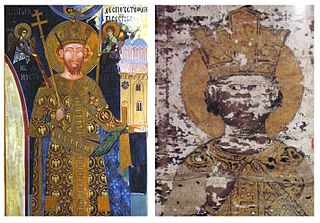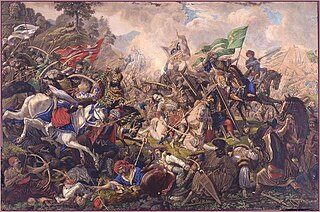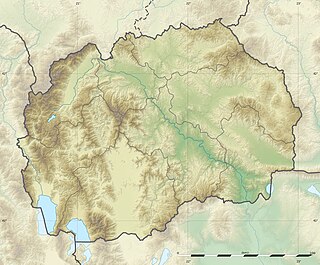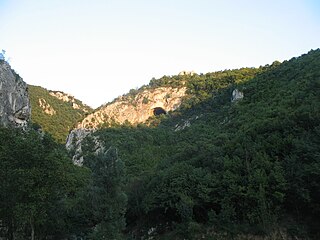 W
WThe Battle of Prilep in the First Balkan War took place on November 3, 1912. The Serbian army encountered Ottoman troops near the town of Prilep, in today's North Macedonia. The clash lasted for three days, and the Ottoman army was overwhelmed and forced to retreat.
 W
WThe Battle of Tripolje, also known as the Battle of Gračanica, was fought in November 1402 between the Serbian Despotate, ruled by the Lazarević dynasty, and the Branković family, aided by the Ottoman Empire.
 W
WThe Battle of Breadfield was the most tremendous conflict fought in Transylvania up to that time in the Ottoman–Hungarian Wars, taking place on October 13, 1479, on the Breadfield near the Saxon village of Alkenyér next to the Maros (Mureş) river. The Hungarian army was led by Pál Kinizsi, István Báthory, Vuk Branković, and Basarab Laiotă cel Bătrân.
 W
WThe Fight on Čelopek or Battle on Čelopek (Bitka/Битка) was fought at the Čelopek plateau near Kozjak between the Serbian Chetnik Organization, a Serbian rebel faction, and Ottoman officers accompanied by Ottoman Albanian bashi-bozuks, on April 16, 1905.
 W
WThe Battle of Dubravnica was fought in the summer of 1380 or December 1381, on the Dubravnica River near Paraćin in today's central Serbia, between the Serbian forces of Prince Lazar of Serbia led by commanders Vitomir and Crep and the invading Ottoman Turks of Sultan Murad I. Vitomir and Crep were the regional lords, and one of their fortresses, Petrus, was in the vicinity of the battle.
 W
WThe Battle of Kosovo took place on 15 June 1389 between an army led by the Serbian Prince Lazar Hrebeljanović and an invading army of the Ottoman Empire under the command of Sultan Murad Hüdavendigâr. The battle was fought on the Kosovo field in the territory ruled by Serbian nobleman Vuk Branković, in what is today Kosovo, about 5 kilometers (3.1 mi) northwest of the modern city of Pristina. The army under Prince Lazar consisted of his own troops, a contingent led by Branković, and a contingent sent from Bosnia by King Tvrtko I, commanded by Vlatko Vuković. Prince Lazar was the ruler of Moravian Serbia and the most powerful among the Serbian regional lords of the time, while Branković ruled the District of Branković and other areas, recognizing Lazar as his overlord.
 W
WThe Battle of Kumanovo, on 23–24 October 1912, was a major battle of the First Balkan War. It was an important Serbian victory over the Ottoman army in the Kosovo Vilayet, shortly after the outbreak of the war. After this defeat, the Ottoman army abandoned the major part of the region, suffering heavy losses in manpower and in war materiel.
 W
WThe Battle of Maritsa, or Battle of Chernomen took place at the Maritsa River near the village of Chernomen on 26 September 1371 between Ottoman forces commanded by Lala Şahin Pasha and Evrenos, and Serbian forces commanded by King Vukašin Mrnjavčević and his brother Despot Jovan Uglješa.
 W
WThe Battle of Monastir took place near the town of Bitola, Macedonia during the First Balkan War, from 16 to 19 November 1912. As an ongoing part of the Balkan Wars, the Ottoman Vardar Army retreated from the defeat at Kumanovo and regrouped around Bitola. The Serbian 1st Army, marching for Bitola, encountered heavy Ottoman artillery fire and had to wait for its own artillery to arrive. On 18 November, following the destruction of the Ottoman artillery by Serbian artillery, the Serbian right flank pushed through the Vardar Army. The Serbs then entered Bitola on 19 November. With the conquest of Bitola the Serbs controlled southwestern Macedonia, including the symbolically important town of Ohrid.
 W
WThe Siege of Novo Brdo was a military blockade of Novo Brdo, an important fortified mining town in the Serbian Despotate, by the forces of the Ottoman Empire. The siege began in 1440 and lasted until the capture of the fortress on 27 June 1441. During the siege, the Serbian garrison was supported by the local community of citizens of the Republic of Ragusa.
 W
WThe Battle of Šumatovac or Battle of Aleksinac happened in 1876, in central Serbia, near the town of Aleksinac. The outnumbered Serbian army, led by colonel Kosta Protić, won a tactical victory in this defensive battle against the Ottoman forces. In a major tactical blunder the Ottomans spent a whole day frontally attacking a well-entrenched pentagonal redoubt defended by two Serbian battalions armed with muzzle-loading rifles and 6 cannons supported by about 40 additional artillery pieces positioned on the overlooking hills. The Ottomans finally retreated towards the end of the day having lost 500 killed and 1,500 wounded and captured. The Serbian army did not press the advantage with a counterattack, however so it ended up as just a tactical success.
 W
WOn 27 May 1904, there was a fight on Šuplji Kamen between the Serbian Chetnik Organization, a Serbian rebel faction, and the Ottoman army under Hamdi Pasha.
 W
WOn March 27, 1905, there was a fight in Tabanovce between the Serbian Chetnik Organization, a Serbian rebel faction, and an Ottoman garrison from Kumanovo.
 W
WOn May 25, 1905, there was a fight in Velika Hoča between the Serbian Chetnik Organization, a Serbian rebel faction, and Ottoman irregulars from Orahovac.
 W
WThe Battle of Zlatitsa was fought on 12 December 1443 between the Ottoman Empire and Serbian Hungarian troops in the Balkans. The battle was fought at Zlatitsa Pass near the town of Zlatitsa in the Balkan Mountains, Ottoman Empire. The impatience of the king of Poland and the severity of the winter then compelled Hunyadi to return home, but not before he had utterly broken the Sultan's power in Bosnia, Herzegovina, Serbia, Bulgaria, and Albania.